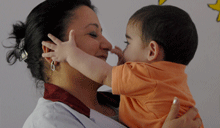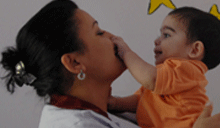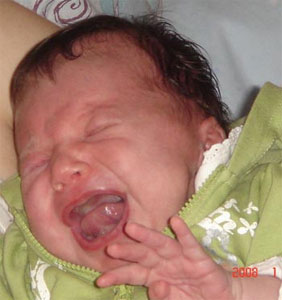
WHAT IS ATTACHMENT BEHAVIOUR?
 |
 |
 |
- There is one big problem with this survival strategy in mammals: the brain of the new-born is not able to function very well, so the baby is helpless – it’s life depends completely on external adult caregivers, especially for the first years of life.
- This is why humans have an attachment system: feeling attached gives the baby security, protection and care. So attachment behaviour is:
- The baby’s tendency to seek for protection, food and nursing from adult caregivers.
- If caregivers leave the baby, it will die. Therefore babies tend to avoid physical separation and respond by attachment behaviour. The attachment system becomes active:
- The attachment system is activated by separation and even only fear of separation.
- Avoiding physical separation is the baby’s only chance for survival.
- The baby avoids separation by clinging, crying, searching for the caregiver, becoming depressed and sad, protesting when the caregiver leaves.
- This is normal and healthy attachment behaviour. Babies who do not respond when the caregivers leave may have given up looking for care (resignation). They may be described as “very calm”, but this behaviour is not normal. Babies who become extremely panicked when caregivers leave may have experienced very difficult and anxious separations. These are not so healthy reactions, and you often see these reactions in orphans whose biological parents were not able to care for them.
QUESTIONS FROM THE INSTRUCTOR TO STAFF
5 minutes
|
 |
QUESTIONS FOR GROUP DISCUSSION
20 minutes
- What are our practices when children show normal attachment behaviours?
- How do we respond (sooth them, scold them, think of them as “disturbing”, do we get stressed when they cry? Or…?).
- What will parents do in our local culture when children show attachment behaviour?
- What did your mothers say about how to handle clinging babies? – your fathers?
CHECKLIST FOR UNDERSTANDING
- Who formed the Attachment Theory?
- Why do only mammals (especially humans) have the attachment system?
- Describe normal attachment behaviour with an everyday example from your work.
- Describe children with very little or with panicking attachment behaviours from your work?
ACTIVITY SUGGESTIONS UNTIL NEXT SESSION
Use your mobile or a camera to record normal attachment behaviour in your daily professional child care. How do different children respond when the caregiver leaves? See it and discuss the reaction of various children and the typical response from various caretakers in the staff.

 English
English







